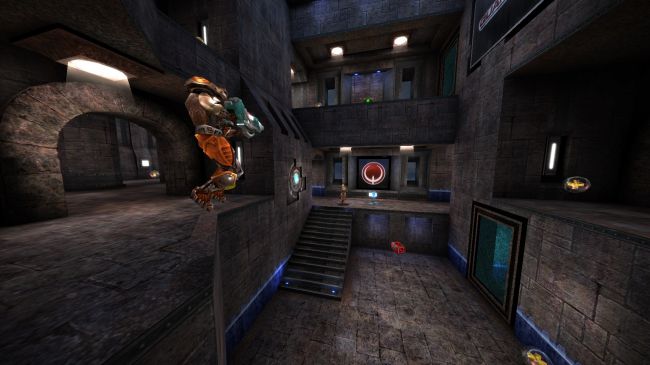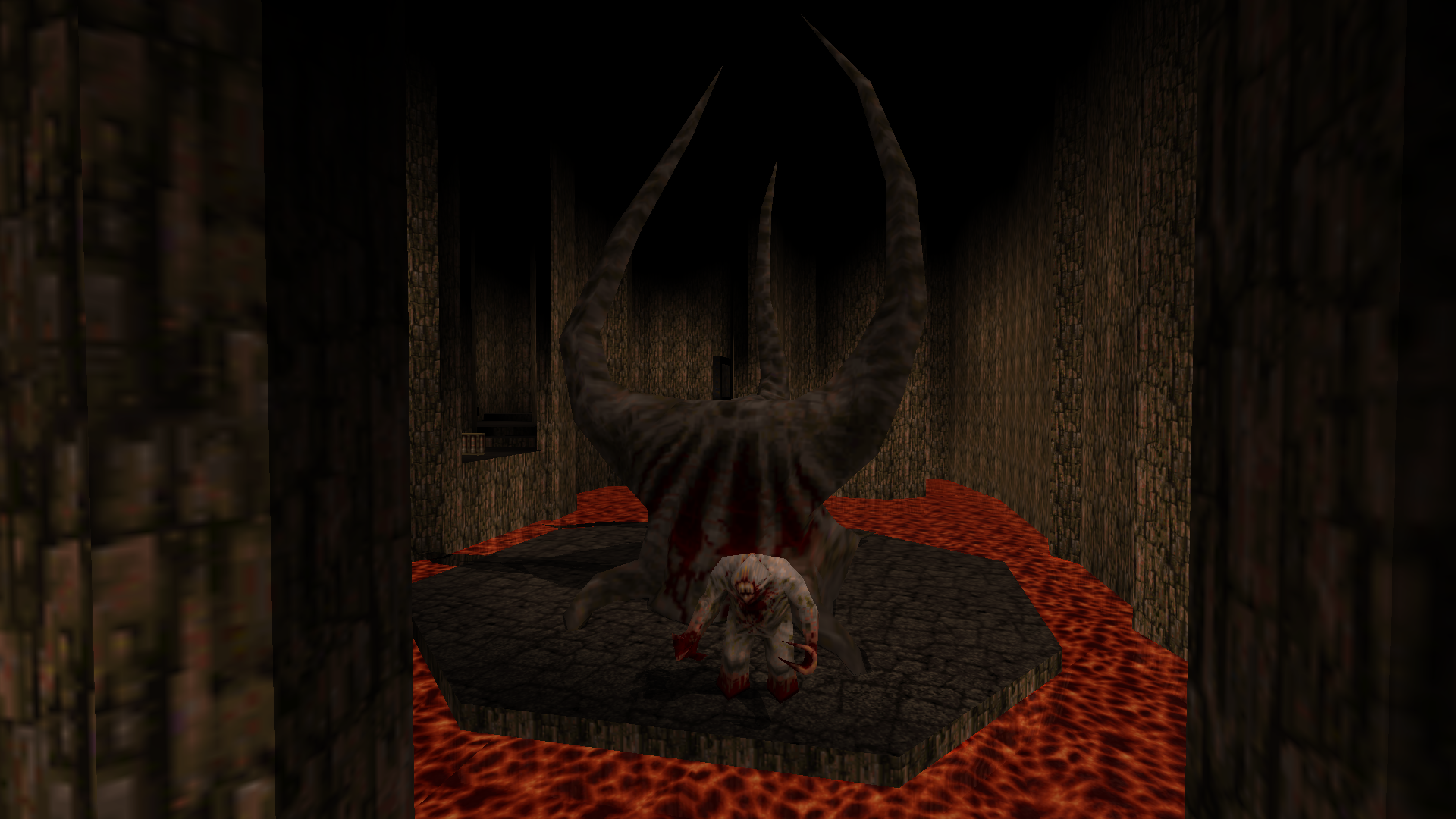What Quake 5 can learn from Doom
A look at the most important lessons from id's latest success.

Doom and Quake are the twin gods of FPS gaming. Their fates are inextricably bonded. With Doom’s recent triumphant return, it’s likely we’ll soon catch wind of a new Quake. The time is ripe, too—it’s been nearly 11 years since Quake 4 released, and revisits to a more traditional, run-and-gun FPS design is a rising vogue. Whether it’ll be called Quake, Quake 5, or Pennsylvania: Quaker’s Revenge, id’s younger sibling can draw from Doom’s strengths and shortcomings to rightfully stand among the pantheon of successful reboots. Here’s a few of its most important lessons.
Provide full mod support
Classic Doom is still being modded over two decades since its release and its thriving WAD community remains a testament to the creativity of its badass and bizarre player content. Even one of its original creators has added to its legacy. The same can’t be said about Doom’s SnapMap, a toolset intended for players to piece together and share custom levels in a seamless process. Its layout curbs complexity for approachability, and while ease-of-use for modding is a welcome concept on the PC, its limitations sorely underscore the lack of true mod support.
Therein lies one of Quake 5’s most important lessons: don’t halfheartedly embrace mods. Grant users the same tools developers wielded to craft the game and entrust the community to figure them out. WAD tutorials and Quake 4 mod beginner guides are a single Google search away; the new Quake’s SDK can easily follow suit. A SnapMap-style system is a console-oriented implementation of modding that won’t and hasn’t achieved uniform success on a platform with modders accustomed to a far greater degree of creativity.
Tell a story, but not forcefully
Id wisely chose to avoid saddling Doomguy with needless characterization. His sole concern is the exquisite art of separating demons from their organs—it’s all he needs to propel the plot, and no grimdark space marine trope can compare in effectiveness. Quake broadly follows suit; you’re a lone warrior pitted against armies of ugly monsters. Combat rules supreme in both universes, and Doom’s exposition was smartly presented as a secondary diversion instead of an unavoidable necessity. Optional data logs and brief first-person sequences of Doomguy punching some computer monitor is the best method for conveying as little or as much story as the player wants.
Quake 5 shouldn’t stray from this angle. Doom’s campaign doesn’t falter if you skip over the finer details of the UAC’s demon enslavement scheme, and neither should Quake slip if you don’t care about the scientific findings of Strogg hair follicles—but it’s there if you want to read about it. Quake naturally fits this narrative method; in Quake 2, you could investigate, skip, or simply blow away MIA marines slowly being assimilated into Strogg.
Go crazy with world design

A jaunt into the demonic home-realm of eternal torment is an inevitable checkmark on Doomguy’s itinerary. The point of departure is a portal swirling in the center of the Mars UAC facility. The compound sports a straightforward rendition of “corporate lab disaster” interior decorating: chromed paneling, beeping science stuff, a neutral-voiced AI calmly recounting horrific casualty rates over the PA, and the occasional culty candle circle. Doom’s depiction of Hell is a surprisingly tame translation: a rockier, redder Mars-style exterior with floating boulders and skulls carved everywhere. For a place acting as the planar trophy hall of conquered dimensions, Hell is less Dali and more Dio album cover.
Fashion a level inside a giant Elder God’s esophagus.
That’s not to say Hell is a visual failure. It accomplishes what it sets out to do as the barracks and arcane library of its demonic denizens. Festooning skulls and pentagrams at every turn is a safe reminder of Doom’s traditional theme. Quake isn’t so clear-cut. We’ve already seen the original Quake’s mythological medieval murk and Quake 2 through 4’s industrial sci-fi. If a new Quake paces with Doom and returns to a classic motif as a modern reboot, it should leverage the power of contemporary hardware and id Tech 6 engine effects to realize a setting with stylistic identity. It doesn’t have to be suffocatingly abstract but expressive enough for it to scream Quake. Top Stroggification. Fashion a level inside a giant Elder God’s esophagus.
The biggest gaming news, reviews and hardware deals
Keep up to date with the most important stories and the best deals, as picked by the PC Gamer team.
Put together a wicked mixtape
Doom’s music feels like riding the edge of a hurricane with the eye of Sauron in the middle. Composer Mick Gordon masterfully captures the seething, pulsing dread of exploring the dual desolation of Mars and Hell—until the ambience shatters with an Imp’s screech. Above the combat’s din of ear-rattling explosions, super shotgun thunderclaps, and the gurgling foley of spilt demon blood rages an auditory transgression. Thrash drum pedal kicks pound metal guitar riffs into the braincage as the synth wails a prayer to carnage. It’s melodized bloodthirst. When Doomguy’s fist plunges into a Gore Nest and Rip & Tear crashes into the soundscape, it’s a too-perfect tap into adrenaline mode.
Quake 5’s soundtrack shouldn’t try for restrained sophistication. Quake favors savagery equally with its older sibling, and id has ample opportunity to sustain the brutality with a crunchy score befitting a violent brawl through Stroggos or Shub-Niggurath’s mystical dimensions. Whatever the new Quake’s choice of theme, it’s important to set a great foundation for a mix of brooding ambience and cacophonous action cuts. Both have worked in the past: Quake’s Lovecraftian Goth paired with Trent Reznor’s darkly atmospheric compositions while Quake 2’s militaristic invasion of an alien world kept rhythm to Sonic Mayhem’s juggernaut metal.
Keep moving and Quaking
[Quake] practically heralded the rise of bunnyhopping and trick-jumping in multiplayer and speedrunning circles.
Both Doom and Quake shaped the very fiber of FPS movement. Their influence is used to this day: mouselook, sprinting, and sustained momentum were all molded by Doom’s simple controls and Quake’s 3D evolution. Doom 2016’s emphasis on old-school speed was a welcome relief to the sluggishness of Doom 3’s more survival horror style, and the frenetic combat reflected the importance of staying in motion to survive a constant threat. Quake is no stranger to this concept; it practically heralded the rise of bunnyhopping and trick-jumping in multiplayer and speedrunning circles decades ago.
As Doom demonstrated, embracing quick movement and level design modeled for circular killing sprees encourages an exhilarating challenge. Quake 5 should stay up to speed by adapting its predecessors’ aptitude for aerial improvisation combined with a mirroring of Doom’s snappy acceleration. If Quake keeps the needle in the red, it’ll hew as close to its roots as Doom did and could cornerstone a new era in speedruns, Defrag races, and acrobatic multiplayer frags.
Make a memorable multiplayer
Id wanted Doom’s multiplayer to embody the genre’s modern standards—a progression system, loadouts, and so on—but it also didn’t want to stray too far off the path beaten by successful games which, paradoxically, elaborated on Doom’s own format over the years. Those contrasts didn’t translate into standout material; sprinkling an area with jump pads and having rockets flying everywhere isn’t some sort of magical pedigree for an arena shooter, and locking away weapons behind the progression system didn’t gel with the equal-footing ethos many came to expect from id.
This is Quake 5’s moment to shine brightly with a strongly defined multiplayer. It boasts the advantage of utilizing an experienced framework tempered by Doom’s easily avoidable inconsistencies and the heritage of Quake 3’s competitive heyday. Its weapons and powerups should evoke the same breathy reverence as the railgun, rocket launcher, and quad damage instead of falling short of character. It should forge heady memories as strong as FFA night on The Longest Yard. Should Quake stay strong with its identity, it may emerge once more as the flag bearer for arena gaming.
Omri Petitte is a former PC Gamer associate editor and long-time freelance writer covering news and reviews. If you spot his name, it probably means you're reading about some kind of first-person shooter. Why yes, he would like to talk to you about Battlefield. Do you have a few days?


